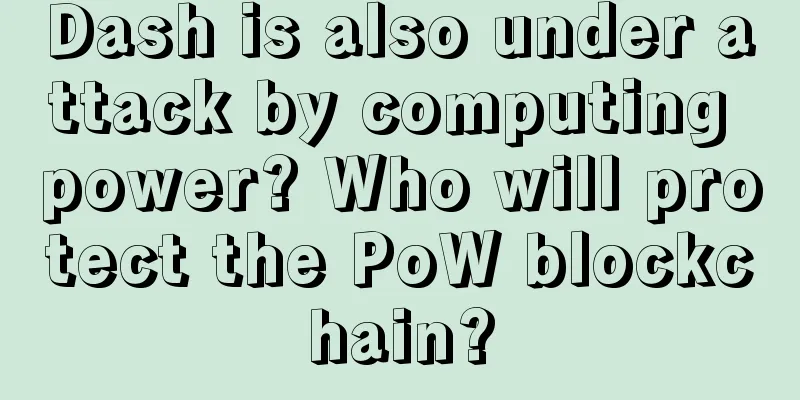Dash is also under attack by computing power? Who will protect the PoW blockchain?

|
Dash (DASH) is a decentralized encrypted digital currency, which is rewritten based on the source code of Bitcoin. Its instant payment technology and good anonymity have made it quickly popular in the cryptocurrency circle. In addition, Dash master nodes can give investors 10%+ annual rebates and vote on monthly budget proposals. But at the same time, the security of such a blockchain system based on the PoW consensus mechanism is as thin as a cicada's wing and may be attacked at any time. Simply put, when the computing power decreases, the PoW blockchain will be exposed to the risk of "51% computing power attack mechanism"! The creator of Dash, Evan Duffield, and his "core team" of nearly 20 people are also aware of this risk and are working tirelessly to design a defense mechanism called Chainlocks. The Ethereum Classic blockchain, which recently suffered a 51% computing power attack, is discussing a defense algorithm, and BCHABC also has a similar mechanism. It seemed to be a race against time to defuse the bomb before the fuse burned out. In fact, during the period after the ETC double-spending attack, a lot of discussions about computing power attacks were rampant. For example, a netizen on the Reddit forum posted such a hot post, which quickly attracted heated discussions from countless netizens. His general meaning was:
As for what exactly is a “51% attack”? And how does the “Chainlocks” defense mechanism work? The warning letter from a user on the Reddit forum reads: The following is the translation of the most discussed original post on Reddit:
After this post was posted, it caused a huge uproar. Many friends responded like this: A friend named Zoden said: "Whether it is Dash or ETC, they are both well-known tokens ranked in the top 20. If they are all conquered, then the day when Bitcoin will be destroyed is not far away, and the entire cryptocurrency circle will be finished !" A person named tranceology3 responded to the above point with a sarcastic remark: " POW is going to be finished, thank you! " Savik519 said: “ I think we are going to see a 51% attack soon. In the near future, more and more tokens will be exposed to risks. ” Dash official response to 51% hashrate attack Is Dash's algorithm really as stated in the post, can it be bought with money? Will DASH really encounter the 51% computing power attack problem? First of all, we need to make clear a fact: Dash currently uses the X11 algorithm, and if you want to mine, the only sensible way is to use ASIC mining machines. So almost all mining machines are currently running at full capacity to mine Dash, and there is no idle computing power resources. Of course, you can buy a small part of the computing power, but you can't buy much unless you are completely rich. No one is stupid enough to use their AISC chip to attack the entire cryptocurrency chain, especially like Dash, where only smaller tokens are more likely to be at risk. To sum it up in one sentence: It is feasible in theory, but extremely difficult to implement in reality. In response to netizens’ questions, the Dash team quickly responded in the Telegram group: The administrator said: Dash has encountered such doubts and challenges hundreds of times in its five years of development, but nothing has happened. Dramatic speculation is rampant, and in fact, Dash’s Chainlocks will launch v0.13 in a few days, and v0.14 will follow shortly after ! Can Chainlocks keep blockchain secure? The various objects of discussion above are actually two: What we just discussed is the potential security risks of network attacks, that is, the "spear" of "51% computing power attack", so what about the "shield" Chainlocks that everyone is talking about and looking forward to? Alexander Block, a core developer of Dash, gave a very detailed technical explanation on the official Dash blog: The emergence of the concept of Long Living Masternode Quorums (LLMQs) enables the implementation of a new protection mechanism against 51% mining attacks. This protection mechanism is called ChainLocks. ChainLocks is a verifiable network-wide measurement/vote based on the "first seen" rule. Each block selects a LLMQ consisting of several hundred master nodes, and each participating member selects the chain that is active at the current height to sign the first block. If enough members (e.g. >= 60%) see the same first block, they can create a P2P message (CLSIG) to propagate it to all nodes in the network. The presence of a valid CLSIG message indicates that a majority of LLMQ members (e.g. 60%) have seen the specified block as the first block. Since LLMQ is composed randomly from Dash's masternode set (currently about 4,900 nodes), the nodes that first saw this block in the network are statistically the same as those inside LLMQ. This means that if 60% of LLMQ members saw the block first, then about 60% of the network should also have seen it first. If a node receives a valid CLSIG message, it should reject all blocks at the same height that do not match the specified block in the CLSIG message. This makes the decision on the active chain fast, simple and clear. It makes forks under this block impossible, and also makes 51% computing power attacks impossible. The blockchain network sees blocks that do not meet the regulations and directly rejects them, maintaining the unity of the main network. The most important impact for ordinary users and merchants is that once a block protected by ChainLocks is confirmed on the chain for the first time, the transaction is considered confirmed. Since it is impossible to reorganize signed/locked blocks, transactions cannot be erased from the chain. This also has an impact on mining economics, removing any incentive for miners to fork the chain. Attacks based on private or individual mining become impossible, as these attacks rely on miners withholding their private chain for a long period of time. Who will protect the security of PoW blockchain? Dash seems to have a protection plan, but what about other chains? The problem of ETC seems to have been discovered three years ago, but it has not been solved. As early as August 2016 (a week after the hard fork of ETH and ETC), ETHNews reporter Brianne Rivlin published an article saying that a mining pool called 51Pool was preparing to launch a 51% computing power attack to destroy the ETC blockchain, but this did not happen. But what was coming has finally come. Now that ETC’s 51% computing power attack has occurred , the ETC team has given the following solutions: develop an early warning plan, recommend that users wait for 2500-5000 block confirmations, wait for ETH to upgrade to the PoS algorithm before the computing power comes to ETC, and adopt the Keccack256 algorithm to prevent mining machine computing power . Among them, the first solution has not yet been finalized, the second solution is for users to protect themselves, and the third solution is to wait for ETH to switch to PoS, and then the computing power will increase after it comes to ETC, so that the difficulty of 51% computing power attack will increase. The last solution has actually been cracked because there are already mining machines with Keccack256 algorithm on the market. The most famous one is the BCH hard fork, which caused asset security issues and huge fluctuations in asset value for BCH users for nearly half a month. Similarly, BCH ABC and BCH SV have faced the threat of computing power attacks from each other . In the November client update, the ABC team added the checkpoints function to prevent SV from reorganizing the blocks. As early as 2010, when Satoshi Nakamoto released Bitcoin version 0.3.2, he mentioned that "adding checkpoints can play a security role. Even if someone has more than 50% of the computing power, he cannot go back to yesterday to reverse the blockchain." A 51% computing power attack seems to be a problem faced by almost all PoW blockchains that have lost computing power and users. We hope that developers can solve these problems, but we find that developers in this world lack certainty and can fork and do something else with just a "disagreement". If we don’t rely on the community or development team to maintain security, then we can only rely on community consensus. However, various stories in the past two years have told us that consensus is fragile and disappears quickly. |
<<: Is Grin Bitcoin 2.0? $100 million has entered the Grin mining market
>>: Grin's launch sparked debate among Bitcoin developers: Is fairness the biggest innovation?
Recommend
Tianfu in the life palace_face analysis
Tianfu Star has a kind heart, is eager to help ot...
Are women with round faces good luck for their husbands? What does a woman with a round face look like?
As one of the traditional physiognomy techniques, ...
Who is the best person to marry for a woman who is unlucky in marriage?
Who is the best person to marry for a woman who i...
Cryptocurrency exchange traffic statistics: Russia, the United States, South Korea, and Türkiye have the largest traffic. What are the regional risks?
According to Similarweb, we can conduct traffic s...
What does a mole on a man’s back mean? What does a mole on the left side of the back mean?
Moles sometimes exist in obvious places, and some...
What does a mole on a woman's left nose mean?
Moles are a very important part in physiognomy, a...
Bitcoin price cut in half, bloodbath in the cryptocurrency market, OKEx may lose its contract position -
Bitcoin price cut in half, bloodbath in the crypt...
Ripple wins a phased victory, XRP's securities attributes are still undetermined, SEC may continue to appeal
On July 13th local time, U.S. federal judge Anali...
Is it good to remove the mole of wealth? What is the mole of wealth?
If a mole on your face is not good, then removing...
What does bad fortune look like?
What kind of facial features indicate bad fortune...
Xiao Lei: Why Bitcoin has not become the second tulip bubble, China needs to respond with caution
From the perspective of current global economic d...
Physiognomy interpretation of active moles: ears
"Live mole" refers to a black and shiny...
The facial features of a stupid person The facial features of a stupid person
In this world, some people are very smart. They h...
Check out several female stars in the entertainment industry with high hairlines
As they age, many men will develop a "Medite...
How to read the meaning of marriage line in palmistry
The marriage line is also called the love line. A...









